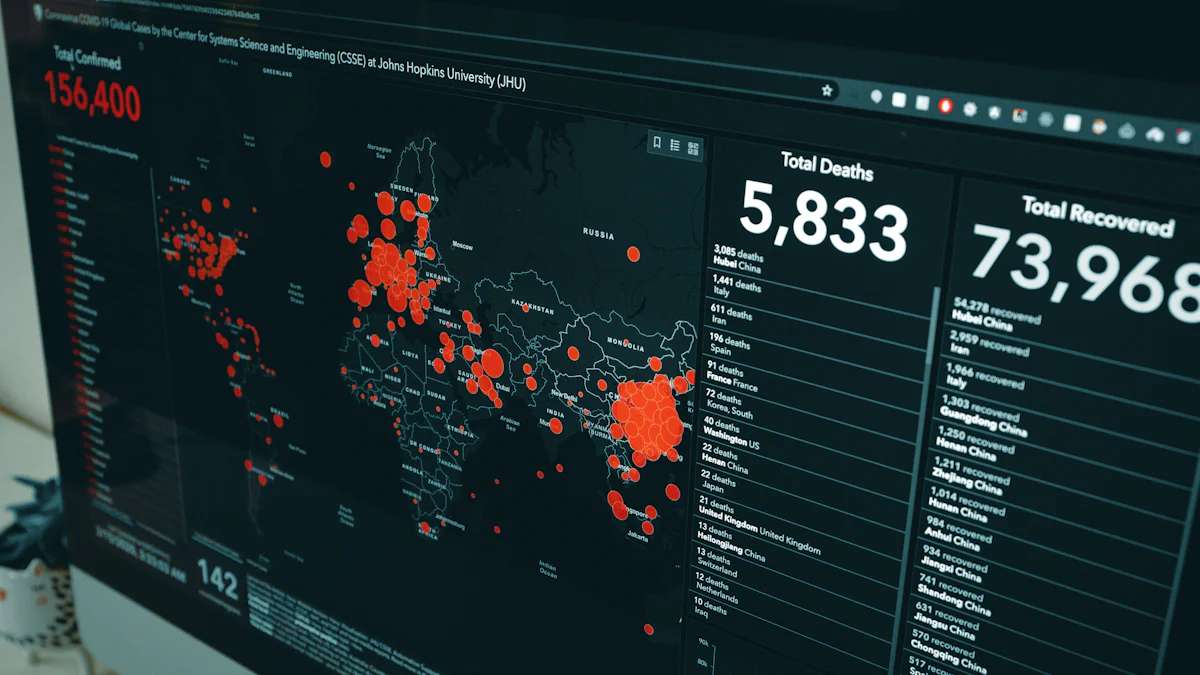


Data visualization transforms complex information into clear, visual insights. One powerful tool in this realm is the Spider Graph. You might know it as a radar chart or web chart. This graph type excels at displaying multivariate data, making it easier to compare different variables at a glance. Understanding Spider Graphs can enhance your ability to analyze and interpret data effectively. They offer a versatile way to visualize performance metrics, helping you see patterns and connections that might otherwise remain hidden.
Understanding the Spider Graph
Definition and Structure of a Spider Graph
What is a Spider Graph?
A Spider Graph, also known as a radar chart, is a unique way to visualize data. It displays multiple variables on a two-dimensional plane, forming a shape that resembles a spider's web. This graph type helps you compare different data points across various categories at once. By plotting each variable on its own axis, you can see how they relate to one another in a single glance.
Components of a Spider Graph
A Spider Graph consists of several key components:
-
Axes: Each axis represents a different variable. The number of axes depends on how many variables you want to compare.
-
Data Points: These are plotted along each axis, showing the value of each variable.
-
Lines: Connecting the data points forms a polygon, which helps you visualize the overall pattern.
This structure makes it easy to spot trends and outliers, providing a clear picture of your data.
How a Spider Graph Works
Data Representation
In a Spider Graph, data representation is straightforward. You plot each variable's value along its respective axis. The distance from the center indicates the magnitude of the value. This method allows you to see which variables score high or low, making comparisons intuitive.
Interpretation of Axes
Understanding the axes is crucial. Each axis corresponds to a specific variable, and the scale remains consistent across all axes. This consistency ensures that you can accurately compare different variables. By examining the shape of the polygon, you can quickly identify strengths and weaknesses in the data set.
Spider Graphs are versatile tools for visualizing multivariate data. They help you make intuitive comparisons and guide strategic decisions. However, be mindful of potential limitations like overplotting and radial scale distortion. Despite these challenges, Spider Graphs remain a powerful way to uncover insights and patterns in complex data.
Types of the Spider Graph
Exploring different types of Spider Graphs can help you choose the right one for your needs. Each type serves a unique purpose, allowing you to visualize data in various ways.
Basic Spider Graph
Single Variable Analysis
A basic Spider Graph can focus on a single variable. This type helps you understand one aspect of your data in detail. You plot the variable across different categories, making it easy to see how it performs in each area. This approach is perfect for highlighting strengths and weaknesses in a specific metric.
Multi-variable Analysis
When you need to compare several variables, a multi-variable Spider Graph comes into play. It allows you to visualize multiple data points simultaneously. By plotting each variable on its own axis, you can see how they relate to one another. This method is excellent for identifying patterns and commonalities among different metrics.
Advanced Variations
Interactive Spider Graphs
Interactive Spider Graphs take data visualization to the next level. They allow you to engage with the data dynamically. You can hover over data points to get more information or adjust the axes to see different perspectives. This interactivity makes them an excellent tool for collaboration and deeper analysis.
Comparative Spider Graphs
Comparative Spider Graphs are ideal for side-by-side comparisons. You can use them to compare different items or datasets under various conditions. This type of Spider Graph condenses extensive information into a single format, making it easier to visualize differences and similarities. It's a powerful way to represent information visually and logically.
Spider Graphs offer versatile tools for visualizing multivariate data. Whether you're focusing on a single variable or comparing multiple datasets, these graphs provide clear insights. By choosing the right type, you can effectively represent your data and make informed decisions.
Practical Applications of a Spider Graph

Spider Graphs aren't just visually appealing; they serve practical purposes across various fields. Let's dive into how you can use them in business, marketing, personal, and educational contexts.
Business and Marketing
Market Analysis
In the business world, understanding market dynamics is crucial. Spider Graphs help you visualize complex market data effortlessly. By plotting different market variables, such as customer preferences, competitor strengths, and product features, you can identify trends and gaps. This visual representation allows you to make informed decisions about product development and marketing strategies. You can quickly spot areas where your product excels or needs improvement, giving you a competitive edge.
Competitor Comparison
Comparing competitors becomes straightforward with Spider Graphs. You can plot various performance metrics like pricing, customer satisfaction, and market share on a single graph. This approach provides a clear picture of where you stand against competitors. It helps you identify strengths to leverage and weaknesses to address. By visualizing this data, you can develop strategies to outperform competitors and capture more market share.
Personal and Educational Use
Skill Assessment
Spider Graphs are excellent tools for assessing skills. Whether you're evaluating your own abilities or those of others, these graphs provide a comprehensive overview. You can plot different skills or competencies on the graph, highlighting areas of strength and those needing improvement. This visual assessment helps in setting personal development goals and tracking progress over time. It's a powerful way to visualize growth and identify areas for further training.
Educational Tools
In education, Spider Graphs serve as valuable teaching aids. They help students understand complex concepts by breaking them down into visual components. Teachers can use these graphs to illustrate relationships between different subjects or topics. For instance, a Spider Graph can show how various factors contribute to a historical event or scientific phenomenon. This visual approach makes learning more engaging and helps students grasp intricate ideas more easily.
Spider Graphs offer versatile applications in both professional and personal settings. They simplify complex data, making it accessible and actionable. Whether you're analyzing market trends, comparing competitors, assessing skills, or enhancing educational experiences, Spider Graphs provide a clear and effective way to visualize information.
Benefits of Using a Spider Graph
When it comes to visualizing data, Spider Graphs stand out for their unique ability to simplify and clarify complex information. Let's explore the benefits they offer.
Visual Clarity
Simplifying Complex Data
Spider Graphs excel at breaking down intricate data into digestible visuals. By plotting multiple variables on a single chart, you can easily spot patterns and trends. This clarity helps you understand the data without getting lost in numbers. Imagine trying to compare several metrics across different categories. A Spider Graph makes this task straightforward by presenting all the information in one cohesive view.
Enhancing Data Interpretation
Interpreting data becomes a breeze with Spider Graphs. The visual representation allows you to quickly identify high and low scores among variables. This feature is particularly useful when you need to make decisions based on data insights. You can see at a glance which areas perform well and which need improvement. This immediate understanding aids in making informed choices efficiently.
Versatility
Adaptability to Various Fields
Spider Graphs are incredibly versatile. Whether you're in business, education, or personal development, these graphs adapt to your needs. They can represent anything from market analysis to skill assessments. This adaptability makes them a valuable tool across different sectors. You can use them to visualize performance metrics, compare competitors, or even track personal growth.
Customization Options
Customization is another strong suit of Spider Graphs. You can tailor them to fit specific requirements by adjusting axes, scales, and data points. This flexibility ensures that the graph meets your unique needs. Whether you want to highlight certain variables or focus on particular data sets, Spider Graphs offer the customization options you need. This feature enhances their effectiveness as a data visualization tool.
Creating a Spider Graph

Creating a Spider Graph might seem daunting at first, but with the right steps and tools, you can easily visualize your data. Let's break it down into a simple guide.
Step-by-Step Guide
Data Collection
First, gather the data you want to visualize. Identify the variables you wish to compare. Each variable will have its own axis on the Spider Graph. Ensure your data is accurate and relevant to the insights you aim to uncover. This step is crucial because the quality of your data directly impacts the effectiveness of your Spider Graph.
Chart Construction
Once you have your data, it's time to construct the chart. Begin by drawing a central point from which all axes will radiate. Each axis represents a different variable. Plot the data points along each axis according to their values. Connect these points to form a polygon. This shape will help you visualize the relationships between the variables. The clearer the connections, the easier it is to interpret the data.
Tools and Software
Creating a Spider Graph becomes even more straightforward with the right tools. Various software options can assist you in crafting professional-looking graphs.
Popular Software Options
Several programs specialize in creating Spider Graphs. Spider diagram maker programs are particularly effective. They help you organize data with logical flows, linking ideas as different branches. These programs often offer templates and customization options, making it easy to tailor the graph to your needs. Popular choices include Microsoft Excel, FineBI, and Google Sheets. Each of these tools provides features that simplify the process of creating and customizing Spider Graphs.
Online Tools
If you prefer working online, numerous web-based tools can help. Websites like Canva and Lucidchart offer user-friendly interfaces for designing Spider Graphs. These platforms often provide drag-and-drop features, allowing you to create graphs without any technical expertise. Online tools are convenient because they enable you to access your work from anywhere, making collaboration with others seamless.
By following these steps and utilizing the right tools, you can create a Spider Graph that effectively communicates your data insights. Whether you're using software or online platforms, the key is to ensure your graph is clear and easy to interpret. With practice, you'll find that Spider Graphs are a powerful way to visualize complex data.
Best Practices of a Spider Graph
Creating an effective Spider Graph involves more than just plotting data. You need to consider several design elements to ensure clarity and accuracy. Let's explore some best practices to make your Spider Graphs both informative and visually appealing.
Effective Design Tips
Choosing the Right Data
Selecting the right data is crucial for a successful Spider Graph. You should focus on multivariate data that benefits from visual comparison across multiple dimensions. This chart type excels at highlighting strengths, weaknesses, and outliers within your dataset. By choosing relevant data, you ensure that your graph provides meaningful insights.
Ensuring Readability
Readability is key when designing a Spider Graph. You want your audience to grasp the information quickly. Use clear labels for each axis and maintain a consistent scale. Avoid clutter by limiting the number of variables you plot. A clean and simple design helps viewers understand the data without confusion.
Common Mistakes to Avoid
Overcomplicating the Graph
One common mistake is overcomplicating the graph. Adding too many variables or data points can make the graph difficult to read. Stick to essential data that supports your analysis. Simplifying your graph ensures that the audience can easily interpret the information.
Misinterpreting Data
Misinterpreting data is another pitfall to avoid. Ensure that each axis accurately represents its variable. Consistent scaling across axes is vital for valid comparisons. Double-check your data points and connections to prevent errors. Accurate representation builds trust in your analysis and conclusions.
By following these best practices, you can create Spider Graphs that effectively communicate your data insights. Remember to choose the right data, maintain readability, and avoid common mistakes. With these tips, your Spider Graphs will become powerful tools for data visualization.
In wrapping up, let's recap the key points. Spider graphs, or radar charts, offer a unique way to visualize complex data. They help you see patterns and make comparisons across multiple variables. This tool is invaluable in fields like business, education, and personal development. You can use spider graphs to brainstorm, plan, and analyze data effectively. They transform complex information into actionable insights, guiding strategic decisions. So, why not explore further applications? Dive into the world of spider graphs and unlock new possibilities for data visualization and analysis.
FAQ
A Spider Graph, also known as a radar chart, visually represents multivariate data. It displays multiple variables on a two-dimensional plane, forming a shape that resembles a spider's web. This graph type helps you compare different data points across various categories at once.
Spider Graphs are excellent for visualizing complex data. They allow you to see patterns and connections that might otherwise remain hidden. You can use them to compare performance metrics, analyze market trends, or assess skills. Their versatility makes them valuable in business, education, and personal development.
Creating a Spider Graph involves a few simple steps. First, gather your data and identify the variables you want to compare. Then, plot each variable on its own axis, radiating from a central point. Connect the data points to form a polygon. You can use software like Microsoft Excel, FineBI, or online tools like Canva to make the process easier.
When designing a Spider Graph, focus on clarity and readability. Choose relevant data that benefits from visual comparison. Use clear labels for each axis and maintain a consistent scale. Avoid clutter by limiting the number of variables you plot. These practices ensure your graph effectively communicates insights.
Yes, Spider Graphs can update automatically if you set them up to refresh from data sources at regular intervals. This feature is particularly useful for monitoring evolving data over time, allowing you to keep your analysis current without manual updates.
While Spider Graphs are powerful, they have limitations. Overplotting can make them hard to read, and radial scale distortion might affect data interpretation. It's essential to use them appropriately and be mindful of these challenges to ensure accurate insights.
Continue Reading About Spider Graph
Augmented Analytics: Unlock the Core Concepts & Benefits!
Discover augmented analytics—where AI and ML automate data prep and insights, revolutionizing decision-making for smarter, faster business strategies!
Lewis
Mar 04, 2025
Dynamic Dashboard: A Game Changer for Data Analysis
Dynamic dashboard revolutionize data analysis with real-time insights, customization, and improved decision-making. Explore their impact and future trends.
Lewis
Oct 11, 2024
Explore the Best Data Visualization Projects of 2025
Discover 2025's top data visualization projects that transform data into insights, enhancing decision-making across industries with innovative tools.
Lewis
Nov 25, 2024
Data Analysis vs Data Analytics: What’s the Real Difference?
Data Analysis vs Data Analytics: What’s the Difference? Discover How One Interprets History While the Other Shapes Tomorrow. Explore Here!
Lewis
Mar 10, 2025
How to Create a Dynamic Chart in Excel Using Named Ranges
Create a dynamic chart in Excel that updates automatically using named ranges and formulas. Learn step-by-step methods for accurate, flexible visualizations.
Lewis
Mar 11, 2025
How to Craft an Effective Analytics Dashboard
Craft an effective analytics dashboard to track metrics and optimize business processes with actionable insights.
Lewis
Nov 15, 2024


